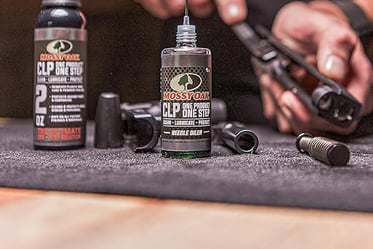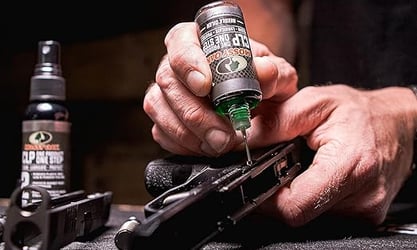2024 Gun Oil Guide: Care & Performance
SURVIVALFRONT PAGE
3/12/20247 min read


What Gun Oil Does: Benefits & Efficacy
Gun oil serves a crucial role in firearm maintenance by providing a lubricating layer that reduces friction between moving parts. This lubrication is essential not only for smooth operation but also for minimizing wear over time, thus extending the lifespan of the firearm's components. The right formulation ensures consistent performance in various environmental conditions, from extreme heat to cold, preventing the metal from expanding or contracting in a way that could impair functionality.
Protective and Performance-Enhancing Properties
The protective properties of gun oil are manifold; it acts as a barrier against environmental contaminants such as dust and moisture, which can lead to corrosion and jamming issues. By creating a thin, impenetrable film over metal surfaces, gun oil also helps to prevent carbon and other firing residues from adhering, which are common causes of operational malfunctions. High-quality gun oils often contain additives that enhance the metal's resistance to extreme pressures and temperatures, thereby maintaining peak performance even under strenuous use.
How Gun Oil Combats Rust and Wear
Rust is the nemesis of any firearm, capable of compromising both its value and function. Gun oil combats rust by displacing moisture and creating a protective coating that isolates the metal from oxygen, an essential element for oxidation processes. Additionally, the anti-corrosive compounds within gun oil actively prevent the chemical reactions that lead to rust, ensuring that the firearm remains in pristine condition. Regular application of gun oil to all metal parts, especially after exposure to moisture or fingerprints (which can contain acids that promote rust), is an indispensable practice for any firearm enthusiast or professional.
Advanced Gun Oil Application: Precision Cleaning Techniques
Precise application of gun oil during firearm disassembly is a fundamental aspect of advanced firearm maintenance, integral to ensuring mechanical longevity and accuracy. The initial step involves the meticulous dismantling of the firearm, adhering stringently to the manufacturer’s schematic to avoid any missteps that could affect reassembly. Selecting a high-viscosity gun oil for this procedure is paramount, particularly for firearms subjected to high round counts or extreme environmental conditions.
Bore Conditioning and Action Smoothing: Commence with the barrel; a phosphor bronze brush, slightly dampened with gun oil, should be employed in a deliberate, spiraling motion through the bore. This technique not only enhances the removal of tenacious lead and copper deposits but also conditions the rifling for improved bullet stability. Within the action, precise droplets of gun oil should be applied using a needle applicator, ensuring every pivot point and slide rail is judiciously coated to diminish metal-on-metal wear.
Systematic Lubrication Strategy: A systematic approach to lubrication, focused on wear-prone areas, can significantly elevate firearm performance. Key stress points—such as bolt carriers, cam pins, and hammer interfaces—warrant a slightly thicker film of oil, facilitating a reduction in friction-induced fatigue. Employ circular, buffing strokes with a microfiber cloth to distribute the gun oil evenly, which enhances the molecular adherence of the lubricant to the metal.
Exterior Metal Surface Treatment: Exterior metal treatment requires a finesse that protects without creating a residue-laden surface. A silicone-treated cloth, imbued with a light polymer gun oil, should be passed over the metal in smooth, overlapping paths, creating a hydrophobic shield against rust-inducing moisture. It’s crucial to resist the urge to saturate; a minimalistic application will suffice, precluding the attraction of particulates that can abrade the finish over time.
Reassembly and Function Testing: After lubrication, reassemble the firearm, paying close attention to the correct placement and orientation of each part. Once reassembled, manually cycle the action to distribute the lubricant internally and conduct a function check to ensure all parts are operating as intended. A correctly lubricated and assembled firearm should exhibit no unnecessary resistance or noise. This final step confirms that the firearm is maintained to a standard that supports peak performance and reliability.
Evaluation and Considerations in Choosing Gun Oil
When selecting gun oil, the primary consideration should be the specific needs of your firearm and your usage habits. Basic mineral oil-based lubricants may suffice for casual use, providing adequate protection at a lower cost. However, firearms exposed to harsh conditions, extensive use, or long storage periods benefit significantly from higher-end synthetic oils. These premium options offer advanced protection against wear and corrosion, thanks to their complex additive packages, including anti-wear agents and corrosion inhibitors, enhancing the firearm's performance and longevity.
The choice between economical and premium gun oils boils down to the firearm's value and the owner's investment in its upkeep. Synthetic oils, while more expensive, have a longer shelf life and maintain their protective qualities over time, even under challenging environmental conditions. The decision should align with the firearm's maintenance requirements and the user's commitment to preserving its condition. Ultimately, investing in a quality gun oil can save on future maintenance costs, ensuring the firearm remains in optimal condition for years to come.
"Check out our guide on tactical assault panels."
Safety Precautions When Cleaning and Lubricating Firearms
Before starting maintenance, always ensure the firearm is unloaded. Remove the magazine, then open the action and visually and physically check the chamber to confirm it's empty. This step is non-negotiable; it’s essential for preventing accidental discharge and ensures a safe environment for cleaning or lubrication. Dispose of used cloths and patches responsibly to prevent fire risks; place them in a metal container with a lid. Store any leftover solvents in their original containers, away from heat, children, and pets.
This approach minimizes fire hazards and environmental risks, keeping the maintenance process safe and responsible. The proper disposal of materials used in the cleaning process, including cloths, patches, and solvents, is equally crucial for maintaining a safe workspace. Used cloths and patches, saturated with solvent and potentially unburnt powder residues, should be disposed of in a metal container with a lid to mitigate fire hazards. Solvents and oils should be stored in their original containers and kept away from direct heat sources, children, and pets. Implementing these disposal and storage protocols significantly reduces the risk of accidental poisoning, environmental harm, and fire, ensuring a secure and responsible maintenance practice.
Diagnosing and Addressing Lubrication Issues at the Range
At the range, over-lubrication can be diagnosed if you notice excessive oil seeping out from the firearm's moving parts or if the action feels sluggish, a result of attracting dirt and debris. To rectify this, field strip your firearm, if safe and practical, using a clean cloth to remove the excess lubricant, focusing on the bolt, slide, and any areas where oil accumulates excessively. Conversely, signs of under-lubrication include a noticeable increase in the effort required to cycle the action or a metallic screech indicating metal-on-metal contact. Apply a few drops of gun oil to the key friction points, such as the slide rails and bolt carrier, ensuring you spread it thinly and evenly to avoid attracting grit.
Incorrect lubricant usage might manifest as a failure to eject or feed properly, which could be due to using a lubricant that's too thick or not designed for the high-temperature environment of a firing mechanism. Switch to a lubricant recommended by your firearm manufacturer or one that's specifically designed for high-heat and high-friction conditions. For optimal maintenance at the range, carry a basic cleaning kit with the correct lubricant and a microfiber cloth. Quick, on-the-spot adjustments can significantly improve functionality and prevent wear, allowing for a continued focus on training or competition without performance being hindered by lubrication issues.
Conclusion: Navigating Gun Oil Selection for Optimal Firearm Maintenance
Selecting the right gun oil is a critical decision that directly impacts the longevity, reliability, and performance of your firearm. Understanding the price points and what to expect at each can further guide your selection process, ensuring you invest wisely in a product that meets your specific needs. Gun oils priced under $8 are typically basic mineral oils suitable for general lubrication and short-term protection, ideal for firearms with minimal exposure to harsh conditions. These options are budget-friendly but may lack advanced additives for anti-wear, corrosion resistance, and stability across temperature variations.
In the $8 to $14 range, gun oils often incorporate more sophisticated formulations, including synthetic blends and additives that enhance performance. Products in this bracket are designed for more serious shooters who require reliable function in diverse environments. These oils offer better protection against wear and environmental factors, making them a smart choice for those looking to balance cost with improved firearm care.
Above $14, premium gun oils provide top-tier protection and performance enhancements. These products typically feature advanced synthetic formulations with specialized additives for maximum lubrication, corrosion inhibition, and longevity. Aimed at enthusiasts and professionals, these oils are engineered to protect high-value firearms and support intense usage, including competitive shooting and tactical operations. While the initial investment is higher, the long-term benefits of reduced wear, extended maintenance intervals, and optimal performance can justify the cost.
Choosing the right gun oil requires weighing the specific needs of your firearm against the performance characteristics offered at different price points. Whether you opt for a basic mineral oil or a premium synthetic blend, regular maintenance using the appropriate lubricant is key to ensuring your firearm remains in peak condition, ready to perform when you need it most.
We recommend the Mossy Oak Gun Lube
"The Mossy Oak Gun Oil offers the best bang for you buck."
As an Amazon Associate items and images linked can earn us commission.
This Guide Covers
What Gun Oil Does: Benefits & Efficacy
Protective and performance-enhancing properties.
Explaining how gun oil combats rust and wear.
Choosing the Right Gun Oil
Factors to consider when purchasing.
Comparing gun oils: Price points.
Maintaining Your Firearm with Gun Oil
Best practices for application and regular maintenance.
Our recommendations for your rifle or gun.
See external references here:
For our article on:
Drones vs. Rifles
onewordsurvive.com
Contact | Questions | Ideas
survive@onewordsurvive.com
Cookie Notice: Our website uses cookies to enhance your browsing experience. By continuing to use our site, you agree to our use of cookies. If you wish to manage your cookie preferences, you may do so in your browser settings.
As an Amazon Affiliate, our team may earn money from qualifying purchases. This page may contain affiliate links, which means if you click through and make a purchase, we may receive a commission at no additional cost to you. This helps support our research and editorial team, and please know we only recommend high-quality products.










